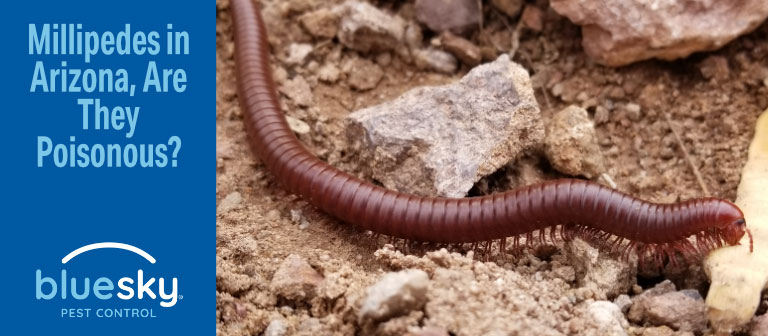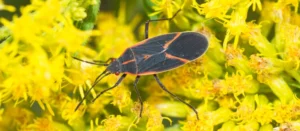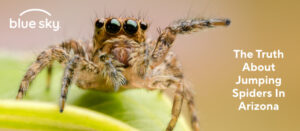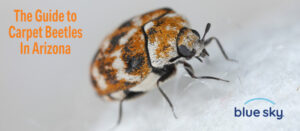$50 OFF New Residential Customers. Learn more
The Millipedes in Arizona Guide: Are They Poisonous?

Millipedes in Arizona may not be the first creatures that come to mind when thinking about the state’s diverse wildlife. However, these multi-legged arthropods are both intriguing and misunderstood. While they might seem like something out of a science fiction movie with their numerous legs and elongated bodies, millipedes play a vital role in the desert ecosystem. In this blog post, we’ll dive into the world of Arizona’s diverse collection of millipedes, exploring their biology, and behavior, and find out if they’re poisonous. If you live in the Phoenix area and you need pest control, we can help! We have offices in Phoenix and Gilbert that make it easy for us to We serve the entire area including Scottsdale, Mesa, Peoria, and Wickenburg. Call us at (480) 635-8492 to get your free quote!
Millipedes in Arizona
Millipedes in Arizona inhabit a variety of ecosystems, from arid deserts to lush forests, making them incredibly adaptable creatures. Their ability to thrive in such diverse environments is a testament to their remarkable survival strategies. Millipedes are thought to be one of the world’s first animals to colonize land from the oceans along with scorpions. These very successful arthropods are often found in dark and moist microhabitats, like leaf litter, decaying logs, or underground burrows, where they can seek refuge from the scorching Arizona sun.
One of the most striking features of millipedes is their segmented bodies, which can be quite long, with up to 400 or more individual segments, each bearing two pairs of legs. Despite their name, millipedes don’t have a thousand legs, but they do have an impressive number, which can vary depending on the species. This unique body structure allows them to move with a characteristic undulating motion, offering both flexibility and stability.
What Do Millipedes in Arizona Eat?
In terms of diet, millipedes are primarily detritivores, meaning they feed on decomposing organic matter. In Arizona’s arid landscapes, dead plant material can accumulate rapidly. Millipedes play a crucial role in breaking down this organic debris. They are nature’s recyclers, helping to return nutrients to the soil and contributing to the overall health of the ecosystem. Their feeding habits also have the added benefit of helping control potential pest populations and maintain ecological balance.
Life Cycle of Millipedes in Arizona
The life cycle of millipedes in Arizona follows a pattern common to these arthropods. It begins with the laying of eggs, often in soil or decaying organic matter, where nymphs hatch. These nymphs undergo several molts as they grow into adult millipedes, characterized by their segmented bodies and numerous legs. Adults engage in courtship rituals, mate, and lay eggs, continuing the life cycle.
On average, millipedes can live for a few years, but some species have been known to survive for over a decade in the right circumstances. Their ability to live for an extended period is one of the factors that contribute to their crucial role in the ecosystem.
Are Millipedes in Arizona Poisonous?
Millipedes in Arizona are not considered poisonous in the true sense of the term. Instead, they are often said to be “chemically defensive.” This means that they possess various chemicals such as hydrogen cyanide, phenols, and various acids among other compounds that can be irritating or even harmful to potential predators or threats. Large millipedes can spray these compounds up to 32 inches, and other arthropods frequently die from exposure to them when contained with a millipede and no ventilation.
The key difference between “poisonous” and “venomous” lies in how these chemicals are delivered and their intended purpose.
- Poisonous: A creature is considered poisonous when it contains toxins or harmful chemicals that can be ingested, touched, or otherwise come into contact with and can harm an organism that interacts with it. In the case of millipedes, they have specialized glands that can produce and release these chemicals as a defense mechanism when they feel threatened. If a predator or curious human handles a millipede and the chemicals come into contact with their skin or eyes, it can cause irritation and burning sensations. However, these chemical defenses are not actively injected or delivered into a potential threat.
- Venomous: In contrast, a creature is considered venomous when it actively delivers venom into its prey or a potential threat. Venomous animals, like certain snakes or spiders, have specialized structures such as fangs or stingers to inject venom directly into their prey or attackers, often for the purpose of immobilizing or incapacitating them.
Are Millipedes Dangerous?
Millipedes in Arizona are generally not considered dangerous to humans or large animals. However, below are a few things to consider when it comes to millipedes:
- Skin Irritation: Millipedes possess defensive secretions that can cause skin irritation in some individuals. If you handle millipedes and their secretions come into contact with your skin, it may lead to redness, itching, or a burning sensation. To avoid this, it’s advisable to handle millipedes with care and wash your hands thoroughly after contact.
- Allergies: While rare, some people may be allergic to the substances in millipede secretions. Allergic reactions can range from mild skin irritation to more severe symptoms.
- Eye and Mouth Irritation: Millipede secretions can be especially irritating if they come into contact with sensitive areas like the eyes or mouth. So, remember to be cautious and avoid touching your face when handling these creatures.
- Pets: Millipedes are generally not a significant threat to larger animals like dogs or cats. However, if a pet ingests a millipede, it may experience gastrointestinal upset or discomfort due to the chemicals in the millipede’s secretions. It’s a good idea to discourage pets from playing with or consuming millipedes.
Are Millipede Bites Painful?
Millipedes are not known for biting. They actually lack the mandibles or fangs that many other arthropods, such as insects or spiders, use for biting or stinging. Instead, millipedes have mouthparts designed for grinding and chewing plant material. These mouthparts are generally not adapted for biting or inflicting harm on humans or animals.
So, while a millipede does not possess the physical means to bite in the way that insects or spiders do, it’s important to be cautious when handling them.
Most Common Types of Millipedes in Arizona
Arizona is home to several species of millipedes, each with its own unique characteristics and adaptations to the desert environment. Here are some of the most common types of millipedes found in Arizona:
- Giant Desert Millipede (Orthoporus ornatus): Perhaps one of the most iconic millipedes in the region, the Giant Desert Millipede is known for its impressive size. It can reach up to 6 inches or more in length. Giant Desert Millipedes vary in color depending on their locale and age. Colors include black and brown, with golden-yellow or reddish bands. These millipedes are often encountered in desert habitats, where they burrow into the soil during the day to escape the heat and emerge at night to feed on decaying plant matter.
- American Giant Millipede (Narceus americanus): This species is found in various regions of North America, including Arizona. It’s a large millipede with a shiny black exoskeleton and red-brown legs. American Giant Millipedes prefer damp environments and can often be spotted in forests, near streams, or in areas with high humidity. They feed on decaying leaves and wood.
- Yellow-Spotted Millipede (Harpaphe haydeniana): While not exclusive to Arizona, the Yellow-spotted Millipede is commonly found in the southwestern United States, including Arizona. It’s characterized by its black body adorned with bright yellow spots along its segments. These millipedes are known for their chemical defense mechanism, secreting a substance that can be irritating to potential predators.
- Green-Striped Millipede (Apheloria virginiensis): Although not as well-known as some other species, the Green-Striped Millipede can be found in various parts of Arizona. They have a greenish-black body with distinctive red or orange stripes running along their segments. Like other millipedes, they are detritivores, contributing to the decomposition of organic matter on the forest floor.
- Flat-Backed Millipedes (Polydesmida spp.): This is a diverse group of millipedes with flat, oval bodies. While not a single species, they collectively inhabit various parts of Arizona and can be recognized by their flattened appearance. Many flat-backed millipedes exhibit striking patterns and coloration, serving as a visual deterrent to potential predators.
Millipedes in Arizona Guide Conclusion
So, whether you find yourself contending with millipedes, ants, scorpions, or any other common pests in Arizona, rest assured that Blue Sky Pest Control is here for you. Our team is well-equipped to address your specific pest control needs with tailored solutions. We understand the unique challenges presented by Arizona’s environment and the importance of maintaining a pest-free living space. With our expertise and commitment to effective pest management, we can customize a treatment plan that works for you. Say goodbye to unwanted visitors and enjoy the peace of mind that comes with a pest-free home or business. Contact us today and let us help you reclaim your space from any pest-related concerns.
Related Posts

Red & Black Intruders: Meet Arizona’s Boxelder Bugs
Boxelder Bugs in Arizona If you’ve ever stepped outside and spotted a cluster of black-and-red bugs crawling on your porch…

Jumping Spiders in Arizona: Harmless or Hazardous?
Jumping spiders in Arizona might be small, but they can sure give you a big surprise when they suddenly appear…

The Guide to Carpet Beetles in Arizona
Carpet beetles in Arizona might be tiny, but they can certainly do some damage. Known for their vibrant, patterned exoskeletons,…